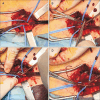Surgical Removal of a Long-Forgotten, Retained Intravascular Foreign Body: A Case Report and Literature Review
- PMID: 39014553
- PMCID: PMC11252483
- DOI: 10.5758/vsi.240037
Surgical Removal of a Long-Forgotten, Retained Intravascular Foreign Body: A Case Report and Literature Review
Abstract
Intravascular foreign body embolization is a potential complication of any vascular operation. Placement of a central venous catheter (CVC) is a common procedure, especially during surgery, hemodialysis, or in critically ill patients. The complete loss of the introducing guidewire into the circulation is a rare complication, with the majority of cases identified immediately or shortly after the procedure. We report an unusual case of an 82-year-old male with a misplaced CVC guidewire, extending from the right common femoral vein (CFV) to the superior vena cava, that was found incidentally 2 years after internal jugular vein cannulation during colorectal surgery. The patient was asymptomatic at the time, without any signs of deep vein thrombosis or post-thrombotic syndrome. Surgical extraction of the guidewire was successfully performed, under local anesthesia, through venotomy of the right CFV. Proper education and advanced awareness are advised in order to minimize the risk of this avoidable complication.
Keywords: Central venous catheterization; Delayed diagnosis; Foreign bodies; Surgery.
Conflict of interest statement
The author has nothing to disclose.
Figures



References
-
- Correia R, Garcia A, Camacho N, Catarino J, Bento R, Garcia R, et al. Intravascular foreign body retrieval. Port J Card Thorac Vasc Surg. 2022;29:45–50. doi: 10.1016/j.ejvsvf.2021.10.008. https://doi.org/10.48729/pjctvs.277. - DOI - PubMed
-
- Arnous N, Adhya S, Marof B. A case of retained catheter guidewire discovered two years after central venous catheterization. Am J Case Rep. 2019;20:1427–1433. doi: 10.12659/AJCR.915941. https://doi.org/10.12659/AJCR.915941. - DOI - PMC - PubMed
-
- Pokharel K, Biswas BK, Tripathi M, Subedi A. Missed central venous guide wires: a systematic analysis of published case reports. Crit Care Med. 2015;43:1745–1756. doi: 10.1097/CCM.0000000000001012. https://doi.org/10.1097/CCM.0000000000001012. - DOI - PubMed
-
- Schummer W, Schummer C, Gaser E, Bartunek R. Loss of the guide wire: mishap or blunder? Br J Anaesth. 2002;88:144–146. doi: 10.1093/bja/88.1.144. https://doi.org/10.1093/bja/88.1.144. - DOI - PubMed
-
- Song Y, Messerlian AK, Matevosian R. A potentially hazardous complication during central venous catheterization: lost guidewire retained in the patient. J Clin Anesth. 2012;24:221–226. doi: 10.1016/j.jclinane.2011.07.003. https://doi.org/10.1016/j.jclinane.2011.07.003. - DOI - PubMed
Publication types
LinkOut - more resources
Full Text Sources

